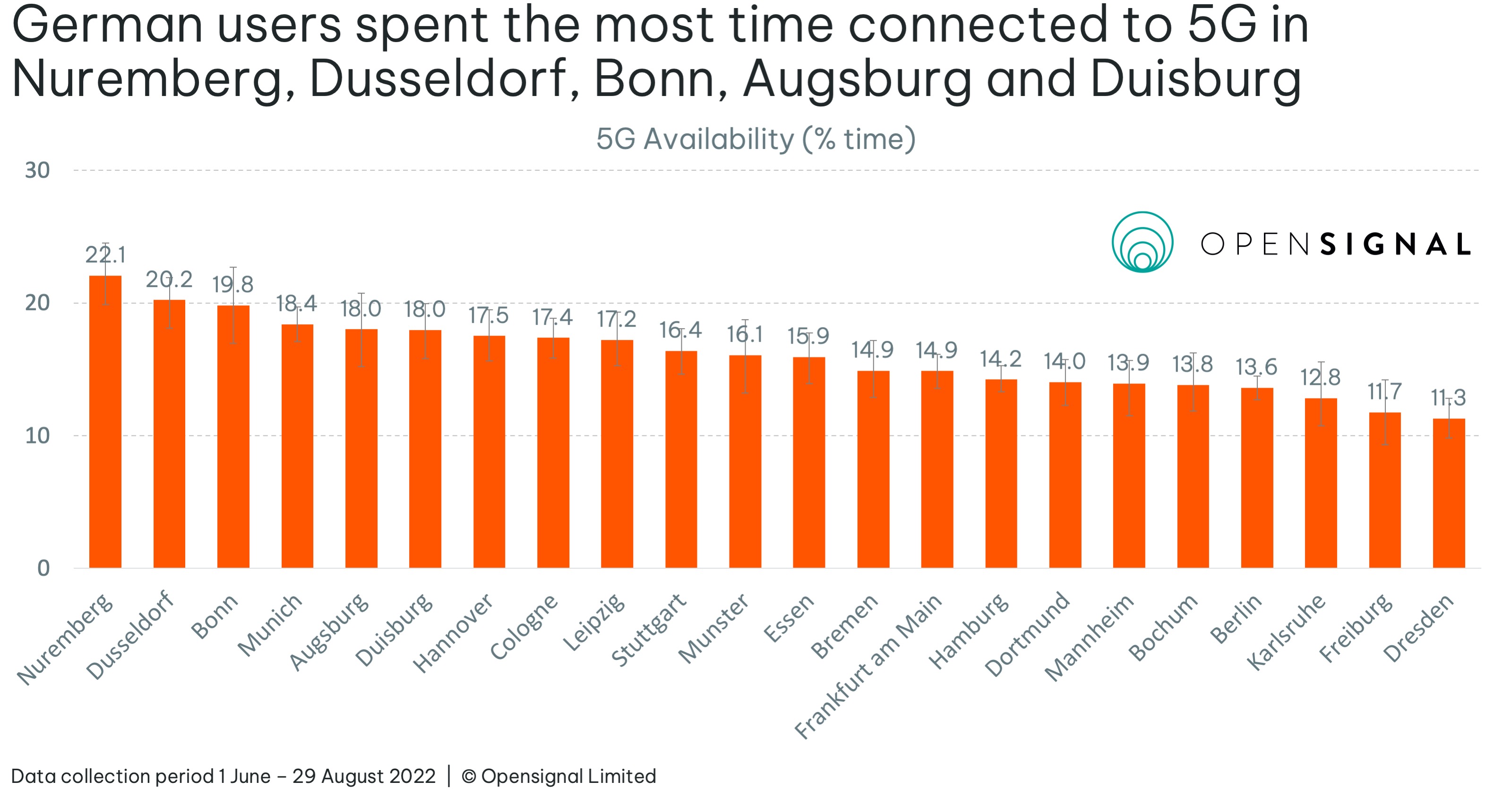Since 5G first launched in Germany three years ago, the operators have been working hard to roll out 5G coverage across the country. It makes economic sense to initially deploy 5G in dense urban areas and therefore many of Germany’s cities benefited from the roll-outs of the new technology. However, there is more to 5G deployments than just whether the technology is present or not — the density and locations of sites, together with the amount of spectrum deployed all influence the urban 5G experience. With this in mind, this latest Opensignal analysis looks at 5G Availability and 5G Download Speed in some of Germany’s largest cities — in terms of the current state of play and comparing it to the experience six, 12 and 18 months ago.

Despite the best efforts of Germany’s operators, our 5G users still have to depend on older mobile technologies for the majority of the time in Germany’s cities. The proportion of time that users had an active 5G connection (5G Availability) ranged from 11.3% in Dresden to 22.1% in Nuremberg. Four cities’ scores were statistically tied with that of Nuremberg — Dusseldorf, Bonn, Augsburg and Duisburg.

Our users observed a significant increase in 5G Availability between late 2020 and mid 2022 across all nine cities analyzed, with the greatest increase in Dusseldorf (12.4 percentage points), while Berlin, Hamburg and Frankfurt am Main saw the smallest increases of 5.4-5.5 percentage points.
However, there are signs of a slowdown in the rate of improvement. In all the cities analyzed — with the exceptions of Frankfurt am Main and Hannover — there were increases in our users’ 5G Availability scores between mid 2021 and late 2021. However, only in Berlin and Dusseldorf were there improvements between the end of 2021 and mid 2022, with increases of 3.2 and 4.2 percentage points, respectively.
This slowdown is because operators face many challenges when deploying 5G in urban areas. At the beginning of 5G deployments, rapid progress can be made by upgrading existing sites. Unfortunately, the high capacity 3.5 GHz band that enables 5G to offer significantly faster speeds than 4G does not propagate as well as the lower frequencies used for 4G — as a result, more sites and denser networks are required to provide seamless 5G coverage.
Adding new sites is often a slow task due to the need for planning permission, negotiations with landlords, along with the drafting and signing of contracts. This matter is complicated both by the need to provide high capacity backhaul — typically in the form of fiber, which means that roadworks and road closures have to be arranged as well. A further source of complexity is Germany’s federal structure, which means that processes and regulations can vary between states. However, help for German operators has arrived, as the Federal Ministry for Digital Affairs and Transport’s (BMDV) latest Gigabit Strategy will include measures intended to simplify the application process for building and site permits.

Switching to the average 5G download speeds in Germany’s largest cities, our users saw their fastest speeds in Bonn and Nuremberg where average 5G Download Speed was over 200 Mbps. At the other end of the scale, Stuttgart and Karlsruhe tied for last place where users’ average speeds were over 50 Mbps slower.

When we analyzed the year-on-year difference between mid 2021 and mid 2022 there were only six out of 14 cities where our users saw faster average 5G download speeds. Of these, five (Dusseldorf, Frankfurt am Main, Hannover, Munich and Nuremberg) saw speeds that were 42.6-54.5 Mbps (27-47.8%) faster in mid 2022 than in mid 2021, while Berlin saw a more modest improvement of 17.3 Mbps (11%).
Turning to the more recent past, there were only four cities in which our users reported significant improvements in the average 5G download speeds between late 2021 and mid 2022. The cities are Nuremberg (52.3 Mbps), Leipzig (29 Mbps), Dusseldorf (26.8 Mbps) and Munich (20.9 Mbps).
The state of 5G is uneven across Germany’s cities
There are great differences in the 5G experience found in Germany’s largest cities, with more than 50 Mbps in 5G download speeds separating the fastest cities from the slowest. Similarly, users in the top scoring cities for 5G Availability spent around double the proportion of time with a 5G signal compared to the city with the lowest score (Dresden).
Our users only observed significant improvements in their 5G Availability and 5G Download Speed experience in a few cities between late 2021 and mid 2022. However, the deployment of a new generation of mobile technology is a marathon not a sprint. The era when 4G was dominant in Germany lasted for almost 10 years between December 2010 and mid 2019. Now, at the start of the 5G era, operators have encountered headwinds and distractions because of the COVID-19 pandemic, which has slowed the 5G roll out. Opensignal will continue to analyze the 5G experience to see how fast 5G improves in the future across the whole of Germany.
Opensignal Limited retains ownership of this insight including all intellectual property rights, data, content, graphs & analysis. Reports and insights produced by Opensignal Limited may not be quoted, reproduced, distributed, published for any commercial purpose (including use in advertisements or other promotional content) without prior written consent. Journalists are encouraged to quote information included in Opensignal reports and insights provided they include clear source attribution. For more information, contact [email protected].
